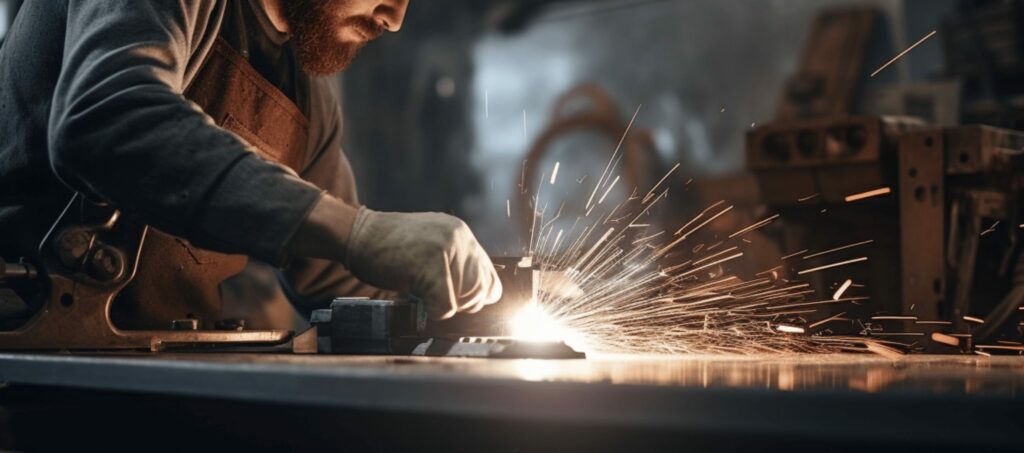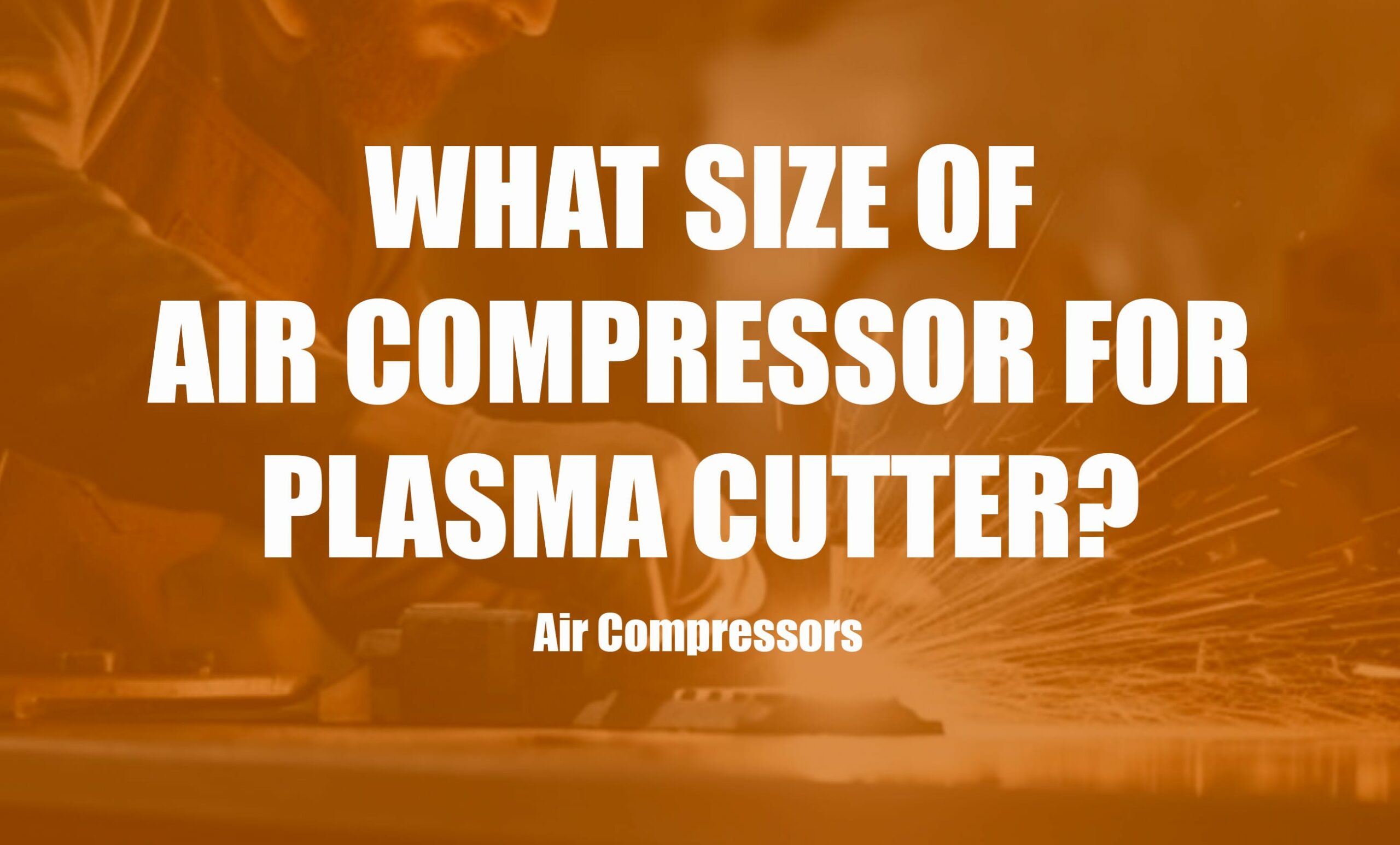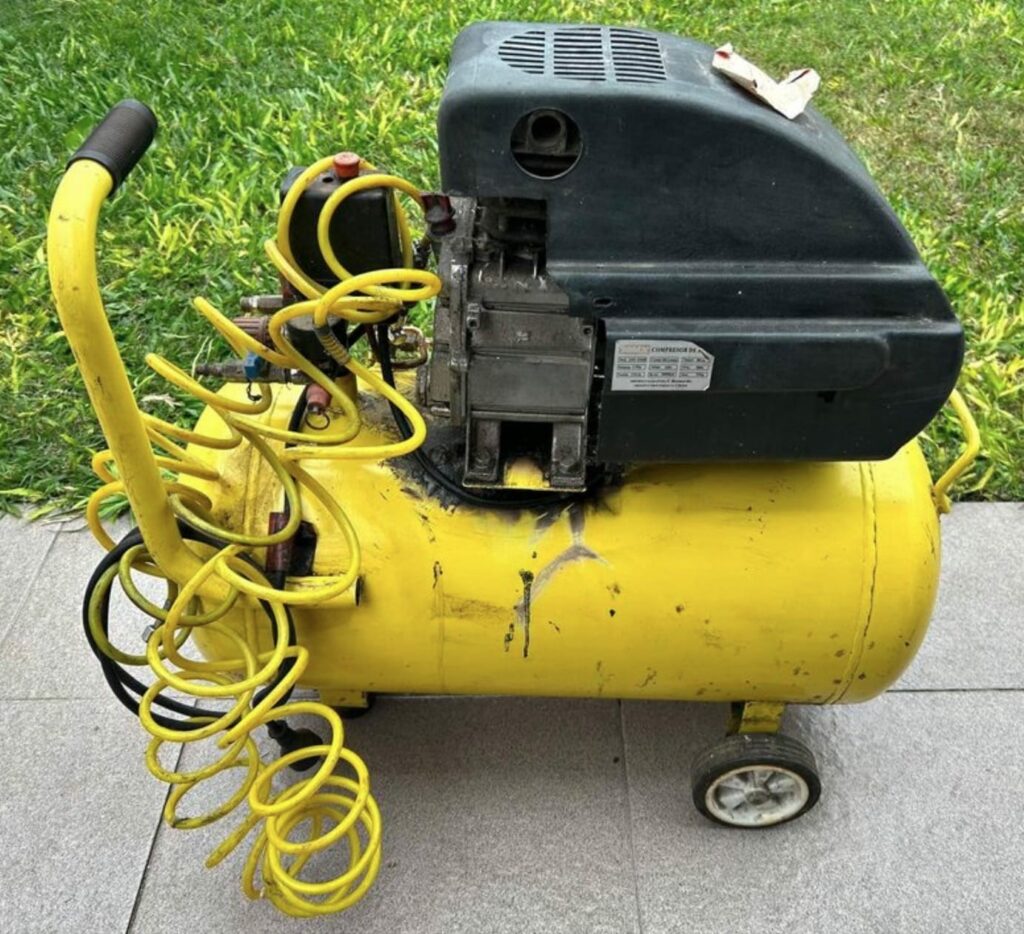If you’re here, reading this article, then you’re likely wondering about the role of air compressors in this process, specifically, what size air compressor is ideal for a plasma cutter.
This is a common question, and the answer is not as straightforward as you might think.
The size of the air compressor you need for your plasma cutter depends on the type of cutter, the scale of your projects, and your specific requirements.
So, here, we’ll delve into these factors and help you make an informed decision.
Let’s start it!
How do Plasma Cutters and Air Compressors Work Together?

A plasma cutter is a powerful tool that uses an electric arc and compressed gas to cut through metal.
It’s like a lightning bolt harnessed within a tornado, where the electric arc (the lightning) provides the heat, and the compressed gas (the tornado) controls and directs the arc.
But why do we need an air compressor for a plasma cutter? Well… the answer lies in the nature of plasma itself.
Plasma is a superheated, ionized gas and in a plasma cutter, this gas is compressed air.
In this dynamic, the air compressor’s job is to provide a steady, controlled stream of this air to the cutter.
Importance of Air Compressor
The performance of your plasma cutter is heavily dependent on your air compressor.
A well-matched air compressor can enhance the efficiency of your plasma cutter, ensuring smooth operation and optimal results.
But, an ill-suited air compressor can hinder your cutter’s performance, leading to subpar cuts and potential damage to your equipment.
What Size Air Compressor for Plasma Cutter?
When I’m choosing the right size of air compressor for my plasma cutter, I always consider the scale of my projects:
For My Hobbyist Projects

For hobbyist projects or light-duty metalwork, I find that a smaller air compressor is usually enough.
The reason?
Well, these projects often involve short, intermittent cuts, which don’t require a high volume of compressed air.
For instance, when I use a small plasma cutter that normally requires 4 CFM at 80 PSI, I find that a 30-gallon air compressor rated at around 6 CFM works just fine.
I mean, this size of compressor provides enough air to keep my plasma cutter running smoothly without interruptions during light usage. And it’s also compact and easy to move around, which is a bonus when I’m working in a small workshop or garage.
For My Professional Tasks
When handling medium-scale applications, such as regular metal fabrication tasks or automotive repairs, I usually need a slightly larger air compressor.
These tasks often involve longer, continuous cuts, which require a steady supply of compressed air.
In these circumstances, you’ll normally need a plasma cutter that requires around 6-7 CFM at 90 PSI, and I’ve found that a 60-gallon air compressor rated at around 10-12 CFM is a good fit.
Why?
Well… this size of compressor ensures that my plasma cutter has enough air to operate efficiently, even during extended cutting sessions. It’s also a good balance between power and size, making it suitable for a professional workshop where space may be limited.
For My Industrial Applications
For large-scale applications, such as industrial metal cutting or construction projects, I always go for a large air compressor.
These heavy-duty tasks often involve extensive, continuous cutting on thick materials, which requires a high volume of compressed air.
In these scenarios, you’ll normally need a plasma cutter that requires around 8-9 CFM at 90 PSI and I’ve found that an 80-gallon air compressor rated at around 15 CFM or more is ideal.
I mean, this size of compressor will be able withstand the rigors of industrial use, with a larger tank capacity and a more powerful motor.
Remember, these are just my experiences. The specific size of the air compressor you need may vary depending on the specifications of your plasma cutter and the nature of your projects.
Tips for Using an Air Compressor With Plasma Cutter
Now that I’ve shared my experiences on matching the size of your air compressor to the scale of your applications, let’s move on to the next section where I’ll share some of my tips for using an air compressor with your plasma cutter.
Keeping it Clean: The Importance of Air Filters
One of the first things I learned was the importance of using an air filter.
Over time, dust and other particles can build up in the air supply, which can affect the quality of the plasma and, consequently, the quality of your cuts.
The air filter helps remove contaminants from the air, which can otherwise clog up my machine and make it less effective.
By using an air filter, I ensure that my plasma cutter is always working with the cleanest air possible, leading to cleaner, more precise cuts.
Regulating the Flow: The Role of Air Regulators
Another tip that has been invaluable to me is using an air regulator.
By adjusting the air flow, I can improve the quality of my cuts and prevent my plasma cutter from overheating or underperforming.
Too much air can lead to unnecessary wear and tear on the machine, while too little air can result in poor-quality cuts.
And, with an air regulator, I can ensure that my plasma cutter always gets just the right amount of air.
Also, I always make sure to adjust the pressure appropriately for the material I’m cutting.
If the pressure is too high, the plasma cutter can overheat and damage itself. If it’s too low, the quality of my cuts can suffer. It’s all about finding that sweet spot for each material.
Understanding the Needs of Different Materials
I’ve also learned that different materials require different amounts of air.
When I’m cutting thick materials, I need to use more air than when I’m cutting thinner materials. This is because thicker materials require more power to cut through, which in turn requires a larger tip on my plasma cutter.
Similarly, thicker materials need more air to ensure a clean, smooth cut.
The Value of Regular Cleaning
Finally, I can’t stress enough the importance of regular cleaning.
A clean machine performs better than a dirty one. Please note this down!
By keeping my plasma cutter clean, I can ensure that it’s always ready to perform at its best.
I make it a habit to clean my plasma cutter after each use, removing any dust or debris that might have accumulated. This not only helps maintain the performance of my plasma cutter but also extends its lifespan.
Best Air Compressor for Plasma Cutter
Craftsman 10 Gallon Peak 1.8 Horsepower Oil-free Compressor
The first thing I noticed about this air compressor is its power.
It’s equipped with a 1.8 peak horsepower induction motor that generates quite a bit of power while keeping the noise level relatively low.
Also, it has a 10-gallon tank, which I’ve found to be more than enough for running a plasma cutter as it provides a steady supply of air, allowing me to work for longer periods without having to stop and wait for the tank to refill.
The tank is made from high-quality steel, ensuring durability and longevity. I’ve been using this air compressor for quite some time now, and it’s still going strong.
What I love about this air compressor is its versatility.
It comes with two quick couplers that can adapt to various applications, from inflating and cleaning to powering different air tools. I’ve used it with my stapler, pinner, brad nailer, roofing nailer, wrench, drill, paint sprayer, caulk gun, and chisel, and it’s performed excellently every time.
And it’s also oil-free and maintenance-free, which saves me a lot of time and effort in upkeep.
Pros
- Powerful 1.8 peak horsepower induction motor: Provides strong power and low noise level
- 10-gallon tank: Offers a large capacity for longer work periods
- High-quality steel tank: Ensures durability and longevity
- Two quick couplers: Adapt to various applications for versatility
- Oil-free and maintenance-free: Saves time and effort in upkeep
- Portable design: Allows for easy movement around the workshop
Cons
- It can be a bit finicky. It sometimes takes a bit of tweaking to get the pressure just right
Frequently Asked Questions
How much air pressure for a 50 amp plasma cutter?
A good rule of thumb that I’ve found is to set the pressure around 60-65 psi for most applications. But, it’s always a good idea to do some test cuts to find the optimum pressure for your specific setup.
Remember, too much pressure can lead to unnecessary wear and tear on your machine, while too little pressure can result in poor-quality cuts.
Will a 30 gallon air compressor run a plasma cutter?
Absolutely! I’ve used a 30 gallon air compressor with my plasma cutter and it works just fine.
In fact, a 30 gallon air compressor can be a great choice for most 30 amp plasma cutters. It can deliver around 5.3 CFM at 90 PSI, which is more than enough for an average weekend work environment.
It’s a good balance between performance and cost, and it can handle most jobs without too many interruptions.
How thick will a 40 amp plasma cutter cut?
A 40 amp plasma cutter can typically cut through materials up to 8mm thick. However, the exact thickness can depend on the specific model of the plasma cutter and the type of material you’re cutting.
For instance, some high-end models can cut through thicker materials, while others may struggle with anything more than a few millimeters thick. As always, it’s best to refer to the manufacturer’s specifications for the most accurate information.


